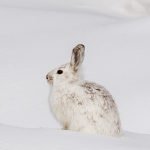THUNDER BAY—Polar bear cubs are adorably cute. At birth, they only weigh up to 1.5 pounds (.6 kg) and within a few months, have grown to 15-30 pounds (6.8-13.6 kg). Adult males weigh 775 to 1,300 pounds (350-650 kg), and females, 330 to 650 pounds (150-290 kg). The height for adult bears is around 3.3 to 5 feet (1-1.5 metres), measured at the shoulder when they are on all fours.
Polar bears—called “Nanuq” in Inuktitut; scientific name Ursus maritimus—are the world’s largest land carnivore. They live on Arctic sea ice and coasts in Norway, Russia, Greenland, The United States (Alaska) and Canada (including the northern edge of Northwestern Ontario).
There’s a fascination with polar bears and seeing them roam wild and free in their natural habitat is an extraordinary experience. A few years ago, I was fortunate to see 21 polar bears while flying in a bush plane along the western Hudson Bay coast while on a tundra-trekking camping trip at the remote sub-arctic 9,093 square-mile Polar Bear Provincial Park in the Hudson Bay Lowlands. During the summer, as the bay’s sea ice melts, several hundred polar bears travel to the coastal areas in the Hudson Bay Lowlands. We saw a mother and two cubs feeding by a small lake; another bear was standing alone on a sandbar, and others walked the tundra, roamed the coastline or splashed along the bay’s shoreline.
About two-thirds of the world’s polar bear population live in Canada, including 13 of the 19 sub-species.
With home ranges that exceed 370,000 miles, they can travel more than 1,800 miles per month. The Polar Bear Capital of the World is recognized as Churchill, Manitoba on the shores of Hudson Bay.
Though famous for their white fur coats, did you know that their fur is actually not white and their skin is black? Their fur is transparent with a hollow core that reflects and refracts light from the sun and off the snow, making it appear white. Heat from the sun is scattered down the hair shaft and is absorbed by their black skin. Polar bears have two layers of fur and solid body fat up to 4-5 inches thick.
Polar bears are classified as a marine mammal as they spend more time on ice than on land and can live 25-30 years in the wild and 38 years (average) in captivity. Strong swimmers, they can paddle at an average speed of six miles per hour; swim sprint up to 30 miles per hour; dive to depths up to 15 feet; and, hold their breath underwater for more than two minutes. On land, they walk at speeds up to three miles per hour. Their paws are huge, measuring up to 12 inches in diameter and have small bumps (papillae) on their footpads to help grip the ice and keep from slipping.
Unlike other bear species like the black bear and grizzlies, polar bears do not hibernate. The exception are female bears during pregnancy when she digs a den and gives birth to her cubs (often twins). They then stay sealed in the den up to eight months until the cubs can survive outdoors; during that time she doesn’t eat, surviving off her body’s storage of fat.
Polar bears rely on blubber (marine fat), primarily from fat-rich seals which they hunt from the sea ice and can eat over 100 pounds of blubber at one time. Polar bears depend on sea ice for their existence, but due to climate change warming, the sea ice is forming later and melting earlier, resulting in bears having to search for other food to survive (e.g. reindeer, eggs of snow geese, rodents, even seaweed).
If seeing the polar bears in the wild isn’t an option, in Ontario you can view them in a habitat as close to wild as possible. It’s at the Cochrane Polar Bear Habitat (CPBH) in Cochrane, Ontario (8-hour drive northeast of Thunder Bay), the world’s only captive bear facility dedicated solely to polar bears. CPBH’s current three resident polar bears—Ganuk, Henry and Inukshuk—have access to several enclosures with trees, rocks, natural vegetation and a swimming pool (visitors can watch them swim through a clear partition at the visitor’s centre).
Polar bears have become the iconic symbol for climate change. And each year on February 27, the International Polar Bear Day raises awareness of the impact of global warming and reduced sea ice on polar bears. The annual event was created by the Polar Bear International (PBI), a group of conservationists, scientists and volunteers with a mission to “conserve polar bears and the sea ice they live on.”





